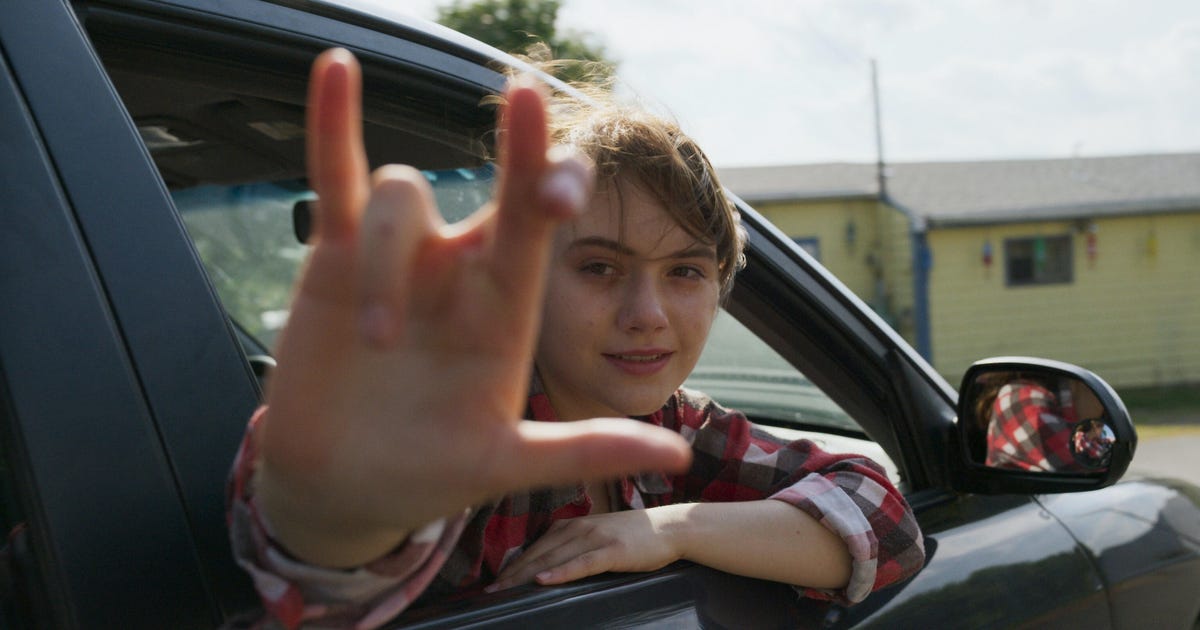Do you remember any of your nightmares from when you were a kid? That’s the question that director Kyle Edward Ball put forth on Reddit a few years back. The answers he received inspired his debut feature Skinamarink, a deeply unnerving waking nightmare that’s crept its way like a cursed object into a few hundred theaters this weekend.
Named after the familiar childhood gibberish song(Opens in a new window), Skinamarink is the story of two young siblings, four-year-old Kevin (Lucas Paul) and six-year-old Kaylee (Dali Rose Tetreault), who get left alone at home one night. Their dad is nowhere to be found, and some unseen presence begins to whisper at them from the dark. And it just gets weirder from there.
Skinamarink is really an experimental art film done up in Paranormal Activity clothing. It has more in common with David Lynch’s bizarre “Rabbits”(Opens in a new window) short film series than it does the campy mainstream slays of the kid-centered horror hit M3GAN. Heck, it makes the acclaimed so-called “elevated horror” canon of the last decade — movies like The Witch, Midsommar, and Get Out — seem like very special episodes of a Chuck Lorre sitcom in comparison.
You want elevated horror? Skinamarink‘s got your elevated horror.
Expanding his 2021 short film “Heck”(Opens in a new window) from thirty minutes into the full-length feature that stands before us today, Ball set down a few strict limitations for himself in his world-building – rules that set the stage right up front for just how out there this movie truly is.

Credit: IFC Films/Shudder
First and foremost, Skinamarink never reveals a single character’s face. At least, they’re never straight on; we see plenty of the backs of heads. Kevin is glimpsed from the side at one especially vulnerable moment. But mostly we’re staring at walls and ceilings, at toys spilled and plays of light, at a staticky TV screen showing the same old cartoon on relentless repeat. The score from those cartoons is the only music we ever hear in the film. Skinamarink‘s soundtrack mostly consists of disassociated voices, ones which shift spatially at random. Suddenly, a voice that sounded far away will be right in your ear and vice versa, and at a certain point these become some of the film’s best jump scares – an aural twist on a cat suddenly leaping into frame.
Cleverly, Ball also keeps his camera at child’s height, creating a sense of smallness, of vulnerability and discombobulation; everything seems impenetrable from down there. A door handle becomes an impossibility. And we never exit the children’s house either. There is no hint of escape. Indeed, we never even see out of any of the windows; the blinds are forever closed, and eventually the windows and the doors (and, in one memorable shot, the toilet) begin disappearing, snapping out of existence altogether.
‘Nanny’ review: One of the best horror movies of the year is now streaming
The concept of “up” and “down” dissolves; furniture starts appearing on the ceiling, and toys begin gathering on the walls. Space and time becomes truly upended; the name of the game in Skinamarink is disorientation. Ball weaponizes every cinematic tool in the box to make us uncertain of what we are seeing and hearing, until we find ourselves actually feeling like children lost in a dark, terrifying, unknown place as well.
Skinamarink is slow cinema on ketamine.

Laura Dern in “Inland Empire.”
Credit: Moviestore/Shutterstock
If you’ve seen David Lynch’s film Inland Empire or his series Twin Peaks: The Return, or if you’ve seen anything Nicolas Winding Refn has directed in the past decade (and please go watch Copenhagen Cowboy(Opens in a new window)(opens in a new tab) on Netflix right now if you haven’t!), then you’re already familiar with the concept of slow cinema. It’s exactly what it sounds like, a cinematic languor that moves like molasses, enveloping the viewer in an atmosphere and mood and a state of mind outside our frantic daily rhythms. Shots are long. Takes are unbroken. Characters are usually static or doing very little inside the frames. Slow motion and repetition are king.
Another excellent example of this genre is Chantal Akerman’s 1975 film Jeanne Dielman, 23, quai du Commerce, 1080 Bruxelles, which was recently named the greatest movie ever made in Sight and Sound‘s most recent poll(Opens in a new window). Available on HBO Max(Opens in a new window)(opens in a new tab), it is mostly about watching Delphine Seyrig fold napkins for three hours. It’s a form that very much demands our patience as much as it demands our attention. Whatever their other motivations for using these techniques, the slow-cinema filmmaker wants to lull us into a trance to suspend us outside of time. They require submission from the viewer — a handing over of the keys to let somebody else drive your brain for a bit.
The best movies on Shudder that you can’t stream anywhere else
In Skinamarink, this means Ball makes us watch a lot of those old cartoons fuzzing in and out. We watch lights turn on in other rooms, and we wait until they turn off. We watch Legos tumble through carpet strands. We listen to footsteps creaking in other rooms as the camera pans snail-speed across the floor. Slowly – so slowly you might not even notice it, which is the point – things start seeming not altogether right. The layout disintegrates. A wrongness insinuates.
The inevitable pull of boredom that tugs at us in slow cinema always has its purpose. Akerman wanted the viewer to experience the excruciating static in Jeanne’s daily routine. Lynch is always tapping into his beloved state of Transcendental Meditation, where a deeper consciousness beyond the one-plus-one-equals-two reigns. There, the connections we make between thought and reality have a dream logic of their own. When I saw Inland Empire for the first time, all I could say about it was that nothing had made me feel more like I was experiencing a dream before, outside of my own dreams.
Skinamarink weaponizes our collective unconsciousness and turns it into a nightmare.
Skinamarink‘s purpose is more nefarious. It totally and entirely wants to terrify us. Skinamarink wants us to become children trapped in our beds again. It wants the very concept of the dark to be foreign, filled with questions and strangeness and terror. Forcing us back to when we were little and we didn’t know more than what was right in front of us, when what lay beyond our hallway or, God forbid, our front door might as well be the edge of the flat earth, falling off into nothingness.

Credit: IFC Films / Shudder
When Ball asked Reddit (as well as the followers of his YouTube channel, “Bitesized Nightmares”(Opens in a new window)) to share their childhood nightmares, he says he began(Opens in a new window) to see patterns emerge from the imagery they shared. Our collective unconscious sometimes has fangs or talons, sometimes hooks or tentacles or terrible black wings. But it’s always crawling around in the dark whispering our names. It’s always steeped in an awful vagueness, an uncanniness that straddles time and space. It’s the monsters moaning in the darkness outside of our caves, just outside the fall of the firelight, their eyes flickering faintly. Skinamarink ties us to the bed like sleep paralysis, and it opens the closet door and peeks under the bed so those monsters can come in and sniff and lick at our heels.
Staring at them is like staring into an abyss. Like we could cross our eyes and behold the shadow of death right before us. There are hints dropped within snippets of conversation we hear throughout the 99 minutes of Skinamarink that nod toward a few concrete explanations for what Kevin and Kaylee are experiencing. Most notably early on, we overhear their father (Ross Paul) telling someone on the telephone that Kevin had fallen and hit his head but that he’s okay now. Does Kevin have a concussion and what we’re witnessing here is his fritzed synapses straining to snap back into place? Is all of this just a bad dream? Or is there really an entity there in the shadows saying that when Kaylee wouldn’t listen to it, it had to take her mouth away?
Damned if I have your answers! Skinamarink is experiential; it demands your submission to the work. And I think, as with all our similar-but-different childhood nightmares, it will whisper ever so slightly warped versions of its several scenarios to each one of us, individually. It’s a Rorschach test of imaginative endurance. But only once you’ve handed yourself over, only once you’ve strapped yourselves into the world’s slowest roller coaster will you even begin to let its monsters in. And if you do – and I say you do it; do it ten times! – then you should hold on for dear life. It will creep, as silent and slow as a predator in the night forest, into the forbidden places that even you’ve forgotten. And it will scratch.
Skinamarink is now on Shudder.
UPDATE: Jan. 30, 2023, 12:47 p.m. EST This review originally ran on January 13, 2023, tied to Skinamarink’s theatrical release. It has been republished in honor of its debut on Shudder.
#Skinamarink #explained #happening #Kevin #Kaylee






